Key Takeaways
- Plan for 1 pound of turkey per adult and 1/2 pound per child to ensure you have enough for your feast
- Prepare dishes like stuffing and mac and cheese in advance to reduce day-of stress
- Create a detailed timeline working backward from serving time to manage cooking efficiently
- Incorporate fresh takes on classic dishes, like our cheesy kale stuffing, to create memorable moments
- Consider dietary preferences when planning your menu to ensure all guests feel included
- Set the right atmosphere with thoughtful lighting, music, and table settings
- Master the art of gravy-making using flavorful homemade stock for exceptional results
- Calculate proper portions for each dish to minimize waste while ensuring abundance
- Develop a strategic plan for leftovers to enjoy creative meals for days after
- Utilize proper food storage techniques to maintain freshness and safety
- Create a welcoming atmosphere with seasonal beverages that complement your meal
- Balance traditional favorites with innovative new dishes to surprise and delight guests
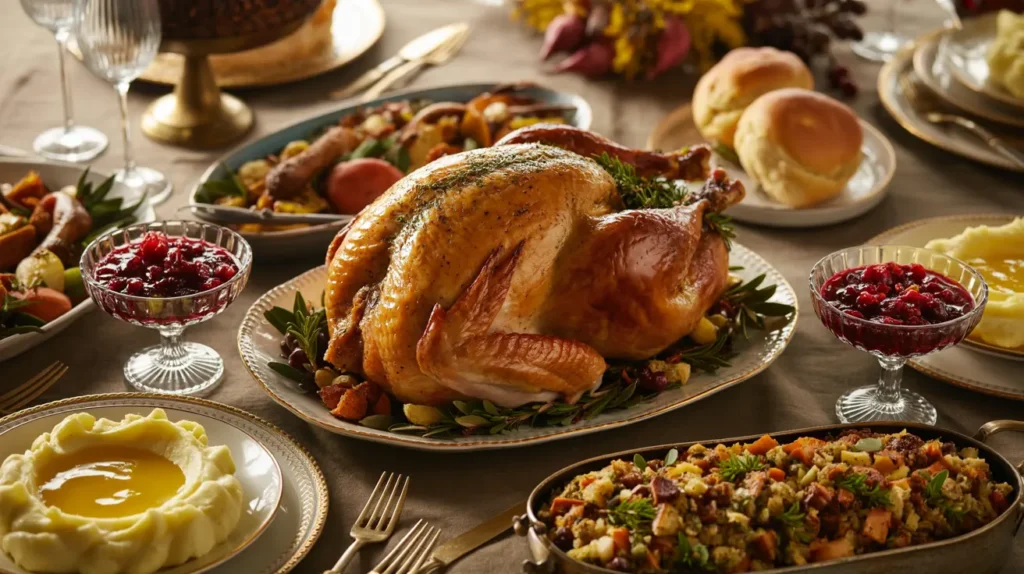
Thanksgiving is that magical time when kitchens become command centers, and home cooks take charge of the year’s most anticipated meal. Whether you’re an experienced host or facing your first turkey, our guide will help you create a Thanksgiving feast your guests will talk about until next November. Here are twelve tips that will make your holiday cooking truly special.
1. Perfect Your Turkey Portions: The Foundation of Thanksgiving Success
The centerpiece of most Thanksgiving tables is undoubtedly the turkey. Getting the size right is crucial – too small and you’ll leave guests wanting; too large and you’ll be eating leftovers until Christmas.
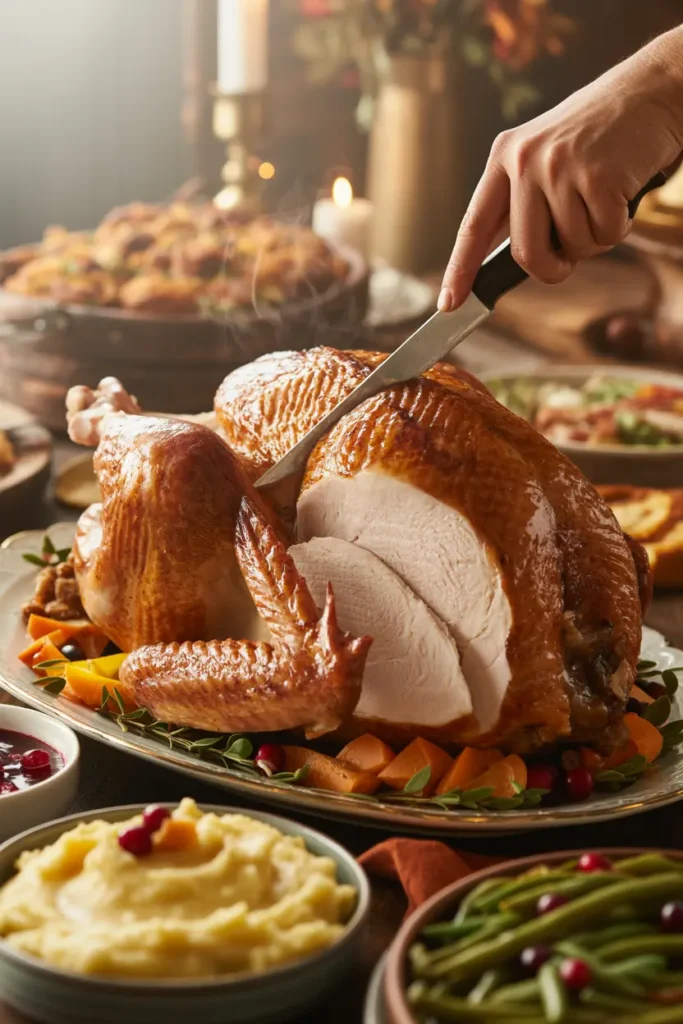
Our golden rule is to plan for 1 pound of turkey per adult and 1/2 pound per child. This accounts for the meat-to-bone ratio and ensures everyone gets their fill of both white and dark meat. For a gathering of 10 adults and 4 children, aim for a 12-14 pound turkey.
Remember that bone-in turkey breasts are an excellent option for smaller gatherings or for those who prefer white meat. Alternatively, consider preparing a secondary protein alongside a smaller turkey – perhaps a glazed ham or a vegetarian main – to provide variety and accommodate different preferences.
When selecting your turkey, fresh birds generally offer better flavor than frozen ones, but require more precise planning. If you opt for frozen, allow adequate thawing time – approximately 24 hours in the refrigerator for every 4-5 pounds of turkey. Nothing ruins Thanksgiving faster than discovering your bird is still partially frozen on Thursday morning!
Brining your turkey—whether through a traditional wet brine or the simpler dry brine method—can dramatically improve both flavor and moisture retention. A basic dry brine of kosher salt, herbs, and citrus zest applied 24-48 hours before cooking creates remarkably juicy meat with minimal effort. Remember to thoroughly pat the skin dry before roasting to achieve that coveted golden-brown exterior that makes for a stunning presentation.
2. Revolutionize Your Stuffing Game with Unexpected Greens
Traditional bread stuffing is a Thanksgiving staple, but why not surprise your guests with an unexpected twist that combines comfort with nutrition?
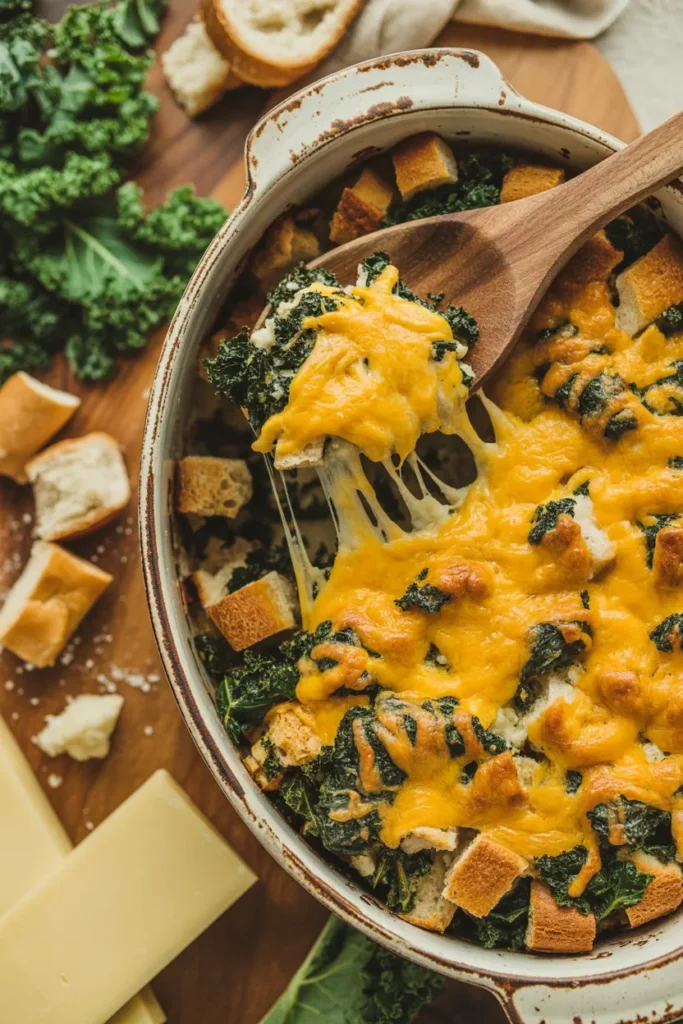
Our Spectacular Thanksgiving Cheesy Winter Green Stuffing with Kale offers a fresh take on the classic. The robust flavors of hearty greens and savory cheese create a stuffing that’s both comforting and sophisticated. The slight bitterness of kale perfectly balances the richness of cheese, creating a memorable side dish that might just steal the spotlight from your turkey.
What makes this stuffing truly special is its make-ahead potential. Prepare it the day before, refrigerate, and simply bake it while your turkey rests. This not only saves precious oven time on Thanksgiving Day but also allows the flavors to meld overnight, resulting in a more complex and delicious dish.
For those concerned about dietary restrictions, this stuffing can be easily adapted. Use gluten-free bread cubes and vegetable broth instead of chicken stock for a vegetarian version that doesn’t sacrifice flavor. The versatility of this recipe makes it a perfect addition to any Thanksgiving spread, regardless of your guests’ dietary preferences.
The technique for achieving the perfect stuffing texture deserves attention—aim for a delicate balance between moist and crispy. The interior should maintain a custard-like consistency while the top develops a golden crust. To achieve this contrast, keep the stuffing covered for the majority of baking time, then remove the cover for the final 15-20 minutes. This method ensures your guests experience both the comfort of the soft interior and the textural interest of the crispy edges in every bite.
3. Master the Art of Thanksgiving Timeline Planning
The secret to a stress-free Thanksgiving isn’t just about what you cook, but when you cook it. Creating a detailed timeline is perhaps the most valuable tool in your holiday arsenal.
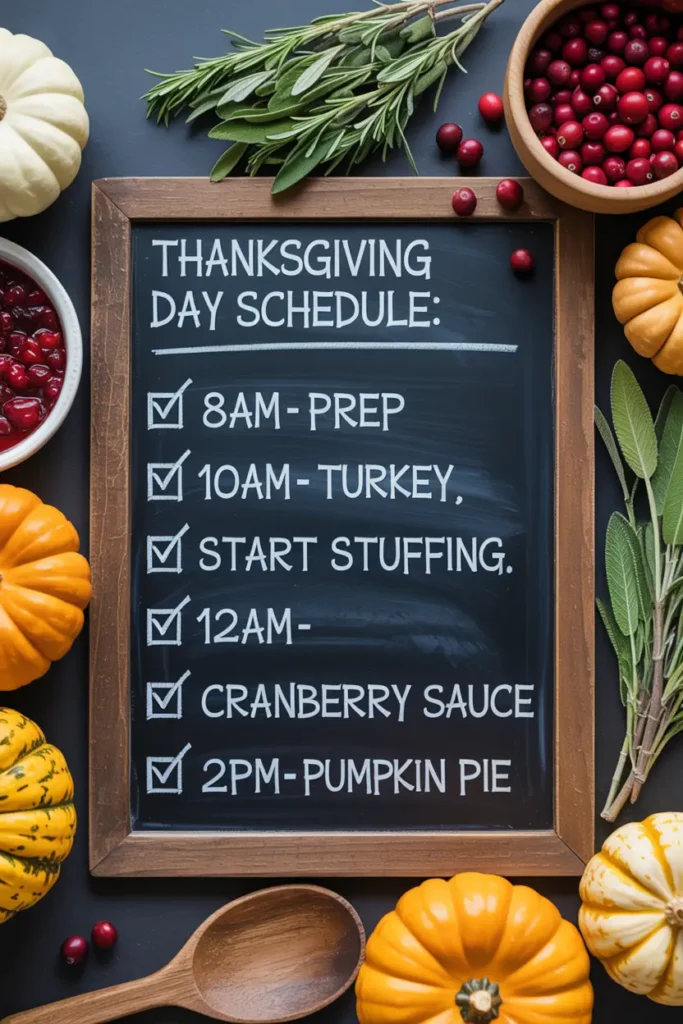
Sample Thanksgiving Timeline
1 Week Before: Shop for non-perishables, clean out refrigerator, prepare and freeze pie dough
3 Days Before: Shop for perishables, brine turkey if desired, prepare cranberry sauce
2 Days Before: Prepare make-ahead sides, chop vegetables, make pie fillings
1 Day Before: Bake pies, set the table, prepare stuffing and refrigerate
Thanksgiving Morning: Remove turkey from refrigerator, prepare potatoes, assemble casseroles
4 Hours Before Dinner: Start cooking turkey
1 Hour Before Dinner: Remove turkey to rest, bake stuffing, warm sides
30 Minutes Before: Make gravy, warm dinner rolls, carve turkey
Work backward from your intended serving time and be realistic about your oven capacity. A single oven can only accommodate so many dishes at once, so plan accordingly. Consider dishes that can be served at room temperature or prepared in alternative appliances like slow cookers, Instant Pots, or even outdoor grills.
Proper planning for Thanksgiving dinner also means delegating where appropriate. Don’t hesitate to assign certain dishes to willing guests – not only does this lighten your load, but it also gives others the opportunity to showcase their specialties and feel part of the celebration.
Remember to build in buffer time for the inevitable delays and last-minute adjustments. Thanksgiving is as much about the experience as it is about the food, and a relaxed host makes for a more enjoyable gathering for everyone.
An often overlooked aspect of timeline planning is equipment management. Take inventory of your cookware, serving dishes, and utensils at least a week before Thanksgiving. Identify any gaps and borrow or purchase necessary items well in advance. Label serving dishes with sticky notes indicating which food they’re intended for, and set them out the night before. This simple step prevents the last-minute scramble to find an appropriate vessel for each dish and ensures everything has its proper place when the meal comes together.
4. Elevate Your Mac and Cheese for Crowd-Pleasing Comfort
Macaroni and cheese might not be traditional Thanksgiving fare in every household, but its universal appeal makes it a welcome addition to any holiday table – especially if children are among your guests.

When preparing macaroni and cheese for a crowd, plan for 1/2 to 3/4 cup of uncooked pasta per person. This might seem like a modest amount, but remember that Thanksgiving plates will be filled with multiple dishes. The beauty of mac and cheese is that it can be prepared in advance and reheated just before serving, freeing up valuable time and kitchen space on the big day.
The secret to truly memorable mac and cheese lies in your cheese selection. A blend of cheeses creates complexity – sharp cheddar provides flavor, while American or fontina offers creaminess. Don’t shy away from adding unexpected elements like caramelized onions, roasted garlic, or even crumbled bacon for an indulgent twist.
For a festive presentation, consider individual ramekins topped with buttery breadcrumbs, or a large casserole with a golden, crispy top achieved under the broiler for the final few minutes of baking. This contrast in textures – creamy interior with crispy topping – elevates a simple comfort food into something worthy of your Thanksgiving spread.
The pasta shape you select can significantly impact your mac and cheese experience. While elbow macaroni is traditional, consider medium shells, cavatappi, or orecchiette, which have nooks and crannies that capture sauce beautifully. Slightly undercook the pasta during the initial boiling—about 2 minutes less than package directions suggest—as it will continue cooking during baking. This prevents the dreaded mushy texture that can plague baked pasta dishes and ensures your mac and cheese maintains perfect al dente consistency even when reheated.
5. Calculate Perfect Portions for Every Guest
One of the most challenging aspects of hosting Thanksgiving is determining how much food to prepare. Too little leaves guests hungry; too much means weeks of leftovers and potential waste.
Thanksgiving Portion Guide Per Person
- Turkey: 1 lb per adult, 1/2 lb per child (uncooked, bone-in weight)
- Stuffing: 3/4 cup per person
- Mashed Potatoes: 1/2 cup per person
- Gravy: 1/3 cup per person
- Cranberry Sauce: 1/4 cup per person
- Vegetables: 1/2 cup of each vegetable per person
- Rolls: 2 per person
- Pie: 1/8 of a 9-inch pie per person
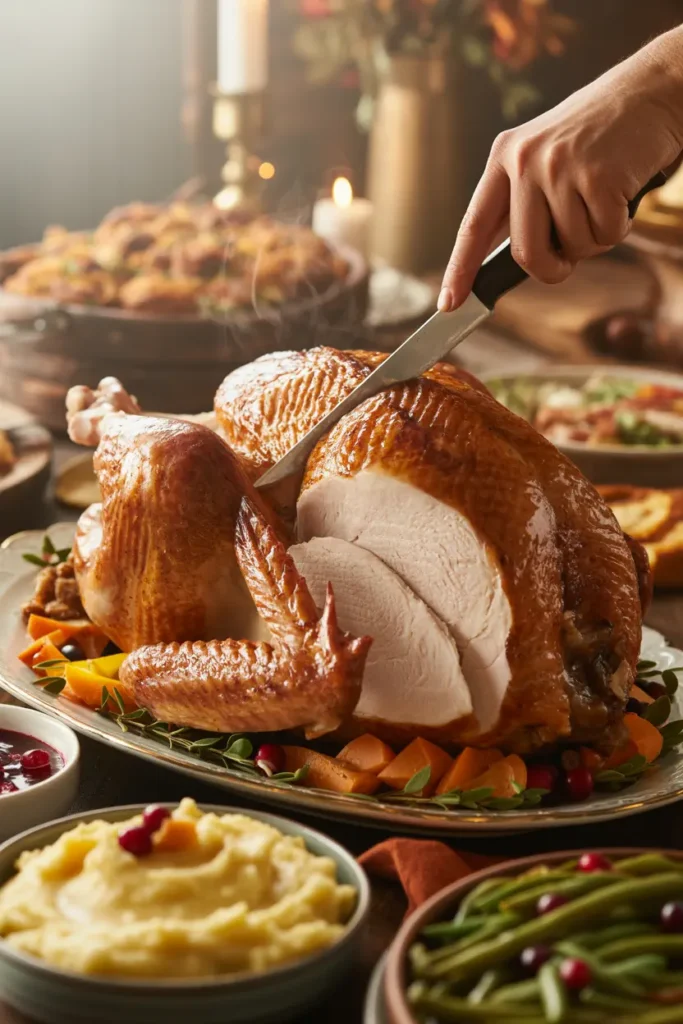
When planning portions for Thanksgiving dinner, consider your specific guest list. A gathering of hearty eaters will require more food than one with many small children or elderly guests. Similarly, if you’re hosting a crowd that loves leftovers, err on the side of abundance.
Remember that the number of side dishes affects portion sizes as well. If you’re offering three vegetable sides, guests will likely take smaller portions of each compared to if you’re only serving one. This “buffet effect” means you can slightly reduce individual portion sizes when offering a wide variety.
For desserts, variety is more important than quantity. Most guests will want to sample multiple desserts rather than having a full-sized portion of just one. Consider offering mini desserts or a dessert “tasting plate” with small slices of different pies and treats.
When calculating quantities for appetizers, timing matters significantly. If your pre-dinner socializing will last more than an hour, plan for more substantial offerings—approximately 5-6 bite-sized appetizers per person. For shorter cocktail periods, 3-4 pieces per guest suffices. Strategically, heavier appetizers should be balanced with the main meal’s richness; if your Thanksgiving menu features particularly indulgent dishes, lighter starters like vegetable crudités or shrimp cocktail help prevent palate fatigue before the main event. Conversely, if your meal tends toward traditional simplicity, more elaborate appetizers can elevate the overall dining experience.
6. Create a Showstopping Tablescape That Enhances the Meal
While food is undeniably the star of Thanksgiving, the environment in which it’s served plays a crucial supporting role. A thoughtfully designed table setting elevates the dining experience and creates a memorable atmosphere for your guests.

Begin with a color scheme that complements the season – rich oranges, deep reds, golden yellows, and earthy browns create a classic autumnal palette. Layer textures through tablecloths, runners, and placemats to add visual interest. Natural elements like mini pumpkins, pinecones, or seasonal foliage make for perfect decorative accents that won’t break the bank.
Lighting sets the mood for your gathering. Soft, warm lighting from candles or string lights creates an intimate atmosphere that encourages conversation and connection. If using candles, opt for unscented varieties to avoid competing with the delicious aromas of your food.
Place cards serve a dual purpose – they add a personalized touch while strategically seating guests to encourage lively conversation. For an interactive element, consider including small cards where guests can write what they’re thankful for, to be shared during the meal.
Remember that practicality matters as much as aesthetics. Ensure there’s enough room between place settings for comfortable dining, and that serving dishes have designated spots. A beautiful but overcrowded table quickly becomes frustrating when guests are trying to navigate the meal.
Consider the vertical dimension of your tablescape to create visual drama without impeding conversation. Varying heights of candles, floral arrangements, or food displays create an engaging visual landscape, but keep centerpieces low enough (under 12 inches) or narrow enough that guests can easily see across the table. Incorporate elements that reflect your personal history or family traditions—perhaps heirloom serving pieces, vintage glassware, or a tablecloth passed down through generations. These meaningful touches transform a beautiful table into a storytelling opportunity that enriches the dining experience with shared memories and cultural significance.
7. Master the Art of Make-Ahead: Meatballs for Appetizers
While turkey typically claims the spotlight at Thanksgiving, thoughtful appetizers keep guests satisfied during the inevitable wait before the main event. Meatballs are an ideal choice – universally appealing, easy to prepare in advance, and adaptable to various flavor profiles.
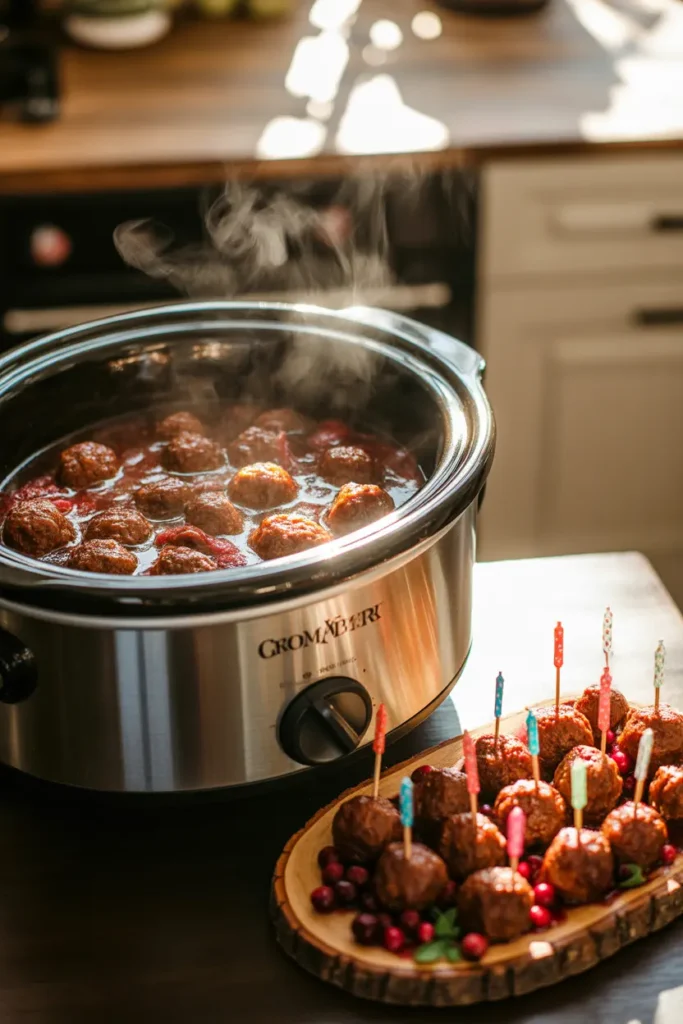
Meatballs for feeding a crowd can be prepared weeks in advance and frozen, then reheated on Thanksgiving Day. This advance preparation is invaluable when managing the complex logistics of holiday cooking. For optimal results when reheating frozen meatballs, thaw them in the refrigerator overnight, then warm them in a slow cooker with sauce. This method ensures they stay moist while freeing up valuable oven and stovetop space.
Consider offering a variety of meatballs with different flavor profiles. Classic Italian-style meatballs in marinara sauce are always a hit, but don’t hesitate to experiment with options like Swedish meatballs with creamy gravy, sweet and tangy cranberry-glazed turkey meatballs, or even vegetarian alternatives made with mushrooms and lentils.
Presentation matters even for simple appetizers. Serve meatballs in a beautiful dish with decorative toothpicks for easy eating, or arrange them on a grazing board alongside cheeses, crackers, and seasonal fruits for an impressive pre-dinner spread that won’t spoil appetites for the main event.
The secret to exceptionally tender meatballs lies in proper ingredient selection and handling technique. Incorporate a panade—a mixture of bread soaked in milk—into your meatball mixture to maintain moisture during cooking. Select meat with sufficient fat content (80/20 ground beef works well) and handle the mixture gently when forming the balls to prevent compaction, which results in tough texture. For consistent cooking, use a small cookie scoop to portion meatballs uniformly. When developing flavor profiles, consider the overall Thanksgiving menu—meatballs with warm spices like cinnamon, nutmeg, and allspice create a cohesive transition to traditional holiday flavors while offering something distinctly different from the main meal.
8. Incorporate Seasonal Beverages That Complement Your Meal
Thoughtfully selected beverages enhance the flavors of your food while adding to the festive atmosphere. A well-planned beverage station allows guests to help themselves, reducing your hosting duties during the busy meal preparation.
For non-alcoholic options, consider warming hot chocolate variations that can be enjoyed before or after the meal. A spiced apple cider simmering on the stovetop not only provides a delicious beverage but also fills your home with inviting aromas. For something unique, try a cranberry-orange punch that echoes the flavors of your meal.
Wine pairings should complement rather than compete with your food. For white wine lovers, a medium-bodied Chardonnay or Viognier stands up well to the richness of Thanksgiving fare. For red wine enthusiasts, Pinot Noir and Beaujolais offer the perfect balance – light enough not to overwhelm turkey but substantial enough for heartier side dishes.

Create a signature cocktail that captures the essence of Thanksgiving – perhaps a maple bourbon smash with fresh sage, or a sparkling pomegranate punch. Offering a special cocktail alongside standard options adds a personal touch to your gathering and creates another memorable element of your celebration.
Don’t forget about after-dinner drinks to accompany dessert. Coffee and tea are standards, but consider making them special with flavored creamers, whipped cream, or liqueurs for those who indulge. A dessert wine like Sauternes or Port makes for an elegant conclusion to your feast.
Temperature considerations are crucial for beverage service—white wines and sparkling beverages should be properly chilled (around 45-50°F for whites, slightly cooler for sparkling), while reds benefit from being served slightly below room temperature (around 60-65°F). Prepare ice buckets or designated refrigerator space in advance. For large gatherings, consider creating clearly labeled beverage stations throughout your entertaining space rather than concentrating everything in one area, which can create bottlenecks. A separate station for non-alcoholic options ensures children and non-drinking guests can easily access refreshments without navigating around alcohol selections.
9. Perfect Your Gravy Technique for Flawless Results
Great gravy can turn an ordinary Thanksgiving meal into something amazing. This simple sauce requires attention to detail, but the results are worth the effort.
The foundation of exceptional gravy is flavorful stock. For the richest results, make turkey stock in advance using the neck and giblets (except the liver, which can add bitterness). Simmer them with aromatic vegetables like onions, carrots, and celery, along with herbs such as thyme, sage, and bay leaves. This can be done days ahead and refrigerated or even frozen until needed.
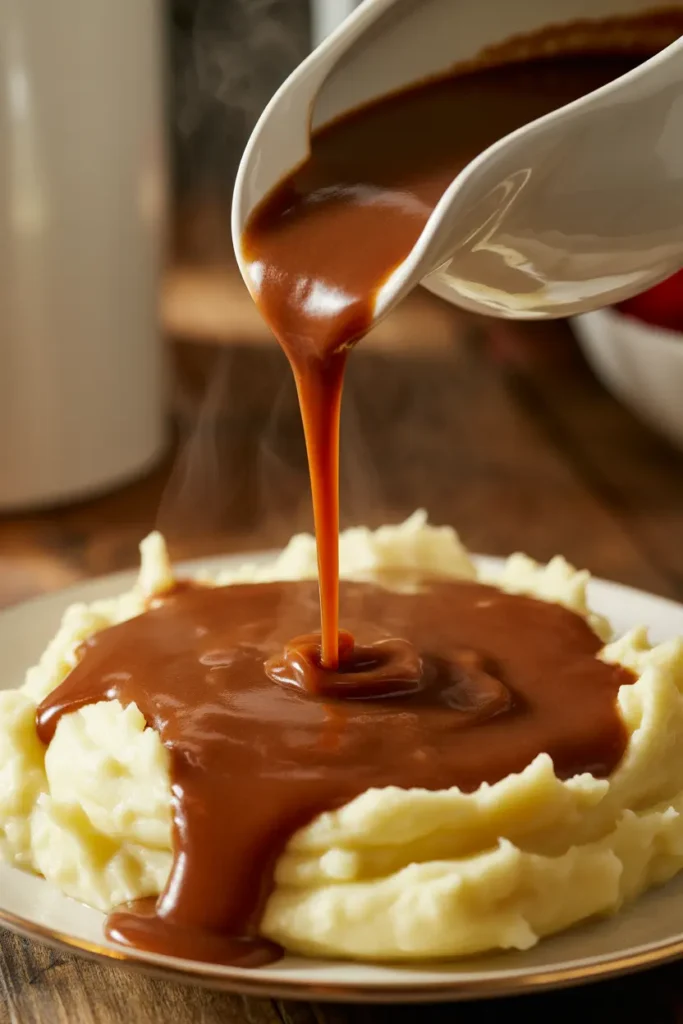
For smooth, lump-free gravy, master the roux technique – cooking equal parts fat (preferably turkey drippings) and flour until it reaches a blonde color before slowly whisking in warm stock. The ratio to remember is 2 tablespoons each of fat and flour per cup of liquid, which yields about 1 cup of gravy. For a gathering of 8-10 people, plan on making at least 4 cups.
Enhance your gravy’s flavor with unexpected additions. A splash of white wine or cognac adds complexity, while a teaspoon of soy sauce or Worcestershire sauce provides umami depth without tasting distinctly Asian or British. For a modern twist, roasted garlic or caramelized onions blended into the gravy create rich, sweet notes that complement turkey beautifully.
If disaster strikes and your gravy develops lumps, don’t panic. Strain it through a fine-mesh sieve or blend it with an immersion blender for a quick recovery. Too thin? Simmer longer to reduce and concentrate flavors. Too thick? Add warm stock gradually until you reach the desired consistency.
The timing of gravy-making presents a unique challenge, as it’s typically prepared after the turkey comes out of the oven but while other dishes need attention. Prepare for this crunch by having all ingredients measured and tools ready. Consider making a “backup gravy base” a day ahead—essentially a rich stock thickened with roux—that can be enhanced with fresh drippings just before serving. This provides insurance against any last-minute mishaps while reducing day-of stress. For silky-smooth restaurant-quality gravy, consider an additional finishing step: after straining, whisk in a tablespoon of cold butter just before serving. This technique, called “mounting with butter,” creates a velvety texture and adds a beautiful sheen to your gravy.
10. Accommodate Dietary Restrictions Without Sacrificing Flavor
Today’s Thanksgiving tables often need to welcome guests with various dietary needs – from gluten sensitivities to vegan preferences. Approaching these accommodations with creativity rather than resignation ensures everyone enjoys an equally delicious experience.
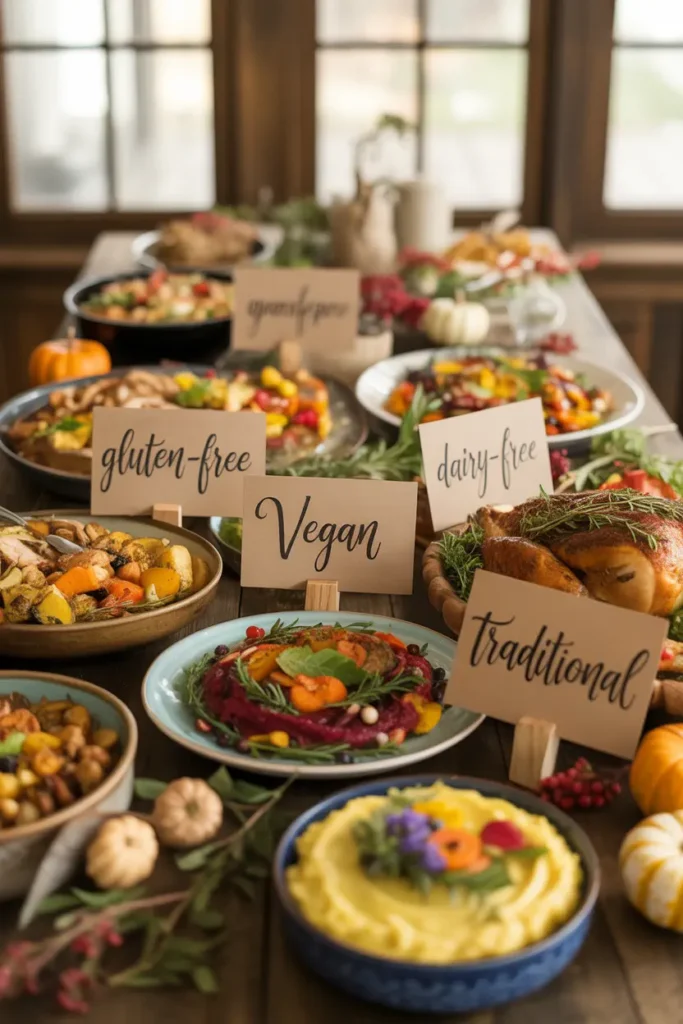

For gluten-free guests, cornbread stuffing made with certified gluten-free cornbread offers a delicious alternative to traditional bread stuffing. Gravy can be thickened with cornstarch or rice flour instead of wheat flour. Many traditional Thanksgiving dishes – like mashed potatoes, roasted vegetables, and cranberry sauce – are naturally gluten-free, so labeling these safe options helps guests navigate the buffet with confidence.
Vegan and vegetarian guests appreciate thoughtful main dish alternatives. Consider a stuffed butternut squash, mushroom Wellington, or lentil loaf that provides protein and satisfaction. Importantly, prepare these dishes with the same care and attention as your turkey – they shouldn’t feel like an afterthought.
Cross-contamination concerns can be addressed through simple planning. Use separate utensils for serving each dish, clearly label foods with common allergens, and consider the order of food preparation to avoid inadvertent mixing of ingredients. These small considerations make a huge difference to guests with serious allergies or sensitivities.
Remember that dietary restrictions don’t preclude indulgence. Vegan pumpkin pie made with coconut milk can be every bit as decadent as traditional versions. Flourless chocolate cake satisfies gluten-free guests while delighting everyone at the table. When everyone can participate fully in the feast, the true spirit of Thanksgiving shines through.
Communication is key when accommodating dietary needs—reach out to guests well before Thanksgiving to understand specific requirements rather than making assumptions. This allows you to plan appropriately and prevents uncomfortable situations at the table. Consider creating a “universal” version of certain dishes where possible—for example, preparing all vegetable sides with olive oil instead of butter makes them accessible to both dairy-free and vegan guests without compromising flavor. When separate versions are necessary, subtle visual cues like different serving dishes or garnishes help identify specialized options without drawing undue attention to them. This thoughtful approach ensures guests with dietary restrictions feel included rather than singled out during the shared celebration.
11. Create a Strategic Leftover Plan for Days of Enjoyment
Thanksgiving leftovers are a tradition unto themselves, but without proper planning, they can become boring or go to waste. A strategic approach to leftovers extends the joy of your feast for days to come.
Begin with proper storage. Invest in quality containers that seal tightly, and portion leftovers appropriately – some for immediate enjoyment and others for freezing. Turkey should be deboned and stored separately from stuffing and sides for maximum flexibility in future meals. Most Thanksgiving leftovers stay fresh in the refrigerator for 3-4 days, while properly frozen items can last for 2-3 months.
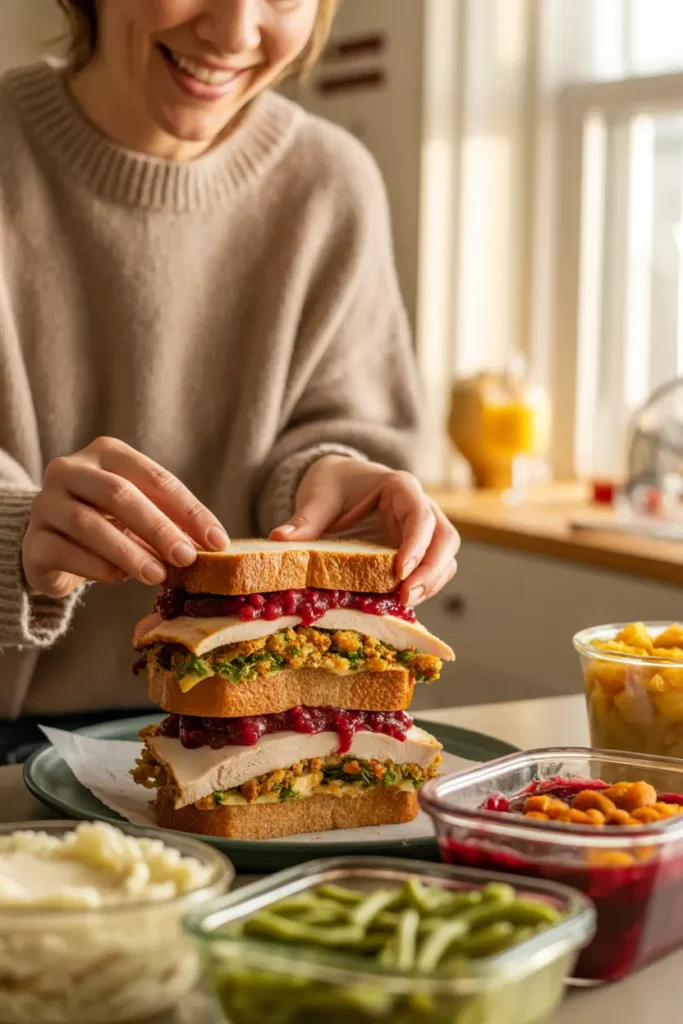
Plan a progression of leftover meals that transforms ingredients rather than simply reheating them. Day one might feature classic turkey sandwiches on artisan bread with cranberry sauce and stuffing. By day two, consider turkey enchiladas with a tomatillo sauce that offers a completely different flavor profile. Day three could bring a turkey and wild rice soup that stretches smaller amounts of meat into a satisfying meal.
Don’t limit leftovers to main dishes. Mashed potato pancakes make a delicious breakfast topped with a fried egg. Stuffing can be pressed into a waffle iron and topped with turkey and gravy for a creative brunch. Cranberry sauce adds brightness to morning yogurt parfaits or afternoon cheese boards.
Send guests home with thoughtfully packed leftovers. Provide quality containers (perhaps purchased inexpensively in bulk) and include a card with reheating instructions or a simple recipe idea. This reduces waste while extending the sharing spirit of Thanksgiving beyond the day itself.
Food safety becomes particularly important with leftovers. Establish a “two-hour rule”—all perishable foods should be refrigerated within two hours of serving to prevent bacterial growth. When packaging leftovers, use shallow containers that allow food to cool quickly in the refrigerator. Create a leftover inventory system—perhaps a simple list on the refrigerator—to track what needs to be used first, preventing forgotten items from languishing until they’re no longer safe to eat. For guests taking food home, provide ice packs for longer journeys. Consider creating a “leftover care package” with complementary ingredients that might not be readily available—a small container of your special gravy, a portion of homemade stock for soup-making, or a bag of artisanal bread for sandwiches—transforming basic leftovers into the foundation for exceptional meals.
12. Set the Perfect Atmosphere with Music and Lighting
The ambiance of your Thanksgiving celebration significantly impacts how your food is experienced and remembered. Thoughtful attention to music and lighting creates an environment where conversation flows and memories form naturally.

Create a playlist that evolves with your gathering. Begin with upbeat, energetic music during arrival and appetizers to establish a festive mood. Transition to more subdued instrumental selections during the meal itself – music that enhances rather than competes with conversation. After dinner, when guests are relaxing with dessert and coffee, jazz or acoustic covers provide a pleasant backdrop for lingering conversations.
Lighting should be warm and flattering, making both your food and guests look their best. Dimmed overhead lights supplemented with strategically placed lamps create a layered effect that’s inviting without being too dark for comfortable eating. Candles add a magical quality to any Thanksgiving table – opt for unscented varieties in varying heights for visual interest without competing with food aromas.
Consider the sensory experience beyond sight and sound. A simmering pot of mulling spices or a subtle seasonal candle in entryway spaces (never at the dining table) creates an inviting atmosphere from the moment guests arrive. Fresh greenery or flowers contribute natural beauty and subtle fragrance.
Most importantly, be present as a host. The most beautiful setting falls flat if the host is too stressed or busy to engage with guests. Build enough ease into your planning that you can step away from the kitchen to enjoy the atmosphere you’ve so carefully created.
Temperature control is an often overlooked aspect of comfort that significantly impacts guests’ experience. Thanksgiving gatherings typically involve many people in a confined space, often with ovens and stovetops running for hours. Monitor your home’s temperature throughout the day and adjust accordingly—what felt comfortable when you were alone in the kitchen may become stifling when twenty people gather in the dining room. Consider lowering the thermostat a few degrees before guests arrive to compensate for the additional body heat. For homes with zoned heating systems, adjust different areas independently based on occupancy and activity levels. Creating a comfortable physical environment ensures guests can focus on the food and friendship rather than personal discomfort, allowing your carefully crafted atmosphere to achieve its full potential.
Conclusion: Your Thanksgiving Legacy Starts Now
Thanksgiving is more than just a meal – it’s an opportunity to create traditions and memories that may echo through generations. The tips we’ve shared are designed not just to help you cook better food, but to create a more meaningful experience for everyone at your table.
Remember that perfection isn’t the goal – connection is. The slightly overdone rolls or the gravy that needed last-minute adjustments will be forgotten, but the warmth of your gathering will linger in hearts and minds. Approach your Thanksgiving cooking with joy rather than anxiety, and that spirit will infuse everything you serve.
Whether you’re hosting for the first time or continuing decades of tradition, each Thanksgiving offers the chance to add your unique signature to the celebration. Perhaps it’s the unexpected kale in your stuffing, the specially curated playlist, or the way you’ve made space for every dietary need without making anyone feel different. These thoughtful touches transform a standard holiday meal into an unforgettable experience.
As you plan your Thanksgiving feast, we invite you to share your own tips and traditions in the comments below. The beauty of this holiday lies in its evolution – the blending of time-honored classics with fresh ideas that reflect our changing lives and families. From all of us at Whaley Cooks, we wish you a Thanksgiving filled with delicious food and even more delicious moments of connection.
Printable Recipe Card
Want just the essential recipe details without scrolling through the article? Get our printable recipe card with just the ingredients and instructions.



